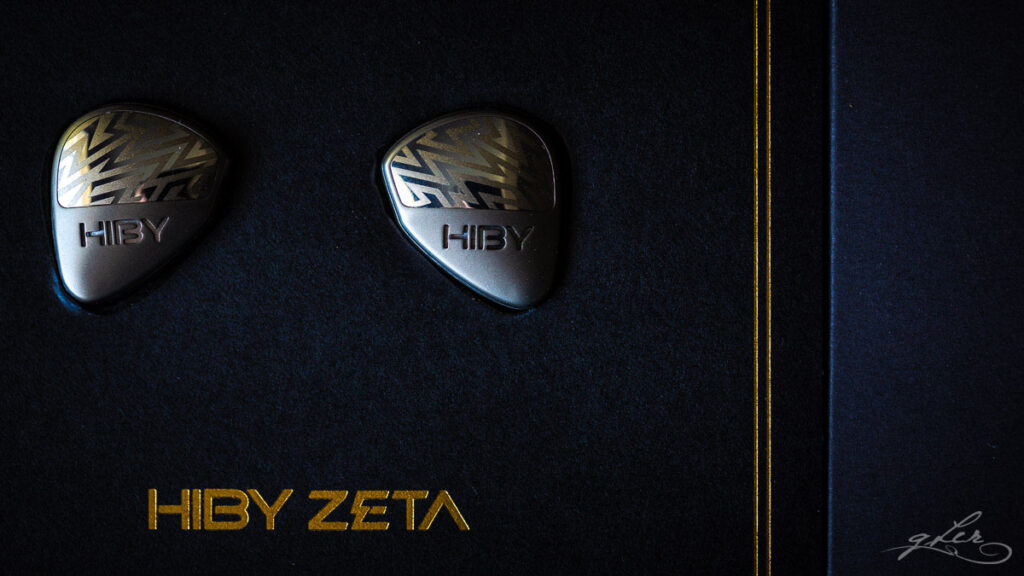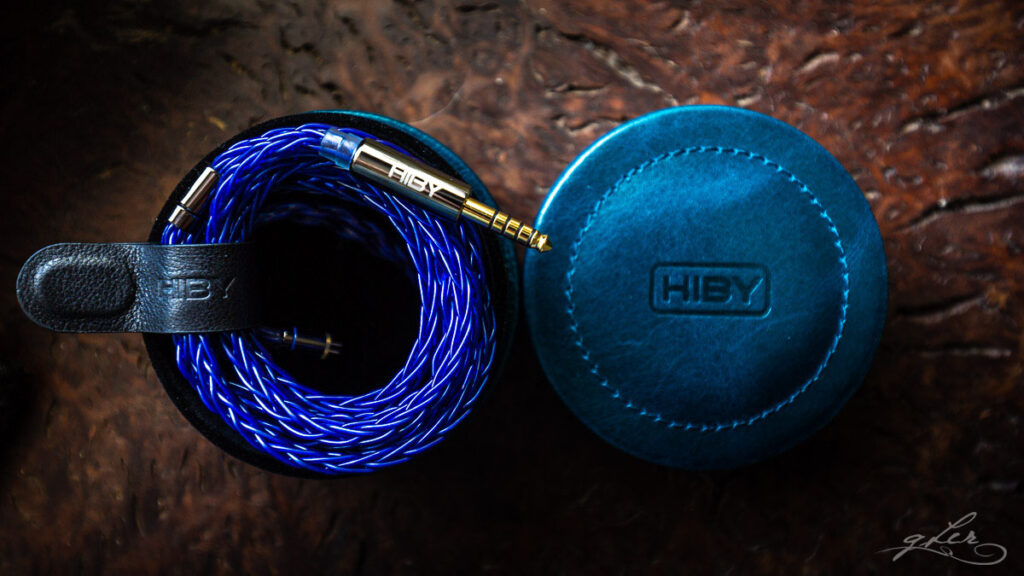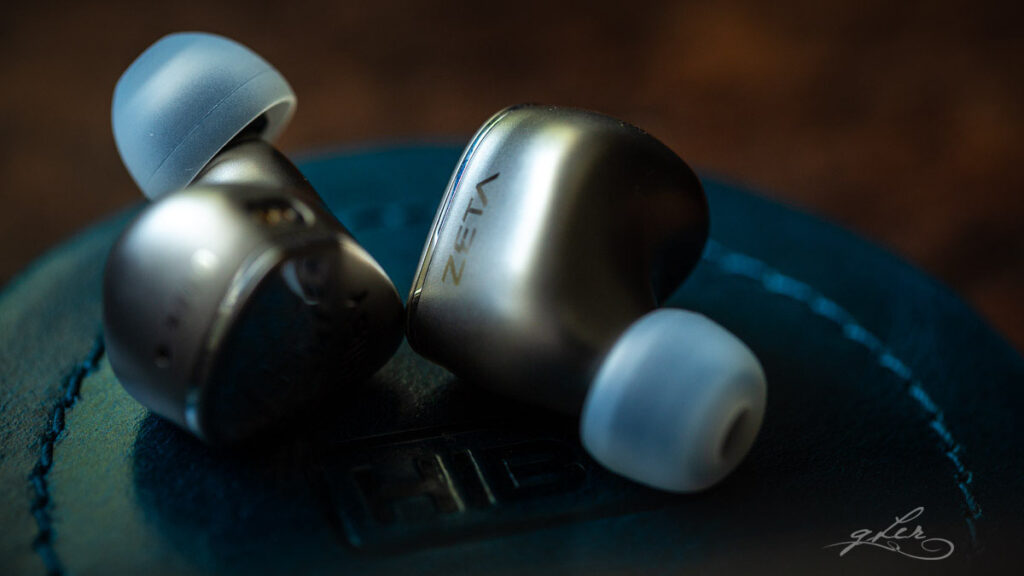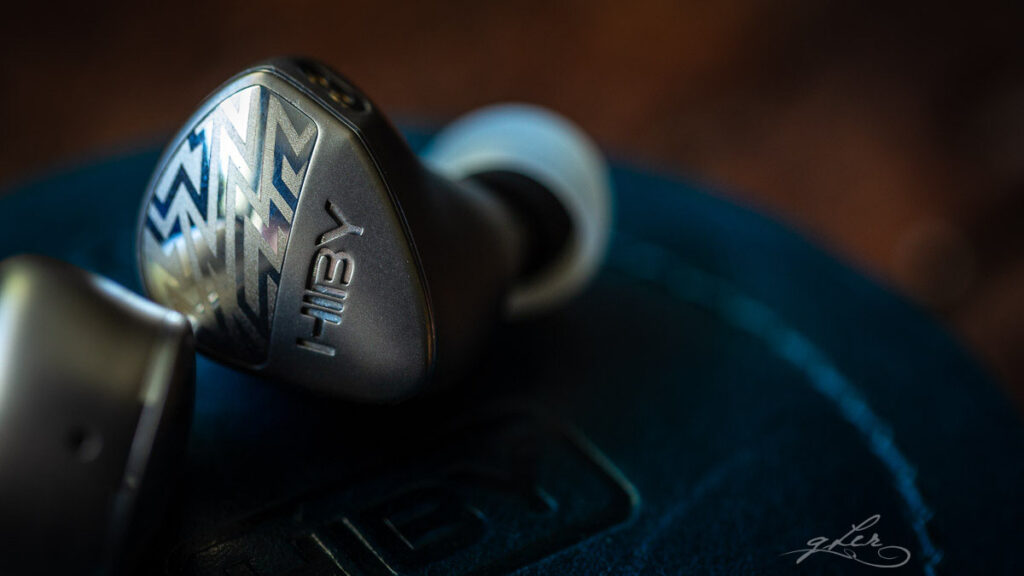Sound impressions
I tested Zeta using a broad selection of test tracks from my library, which predominantly comprises newer music of the female vocal indie persuasion, along with pop, synth-pop, classic rock, cinematic and singer-songwriter classics. I also sampled various other music types I occasionally listen to, like EDM, ambient, classical and vocal jazz, and where relevant, I’ve included track notes in the review.
All listening was done with a variety of sources too, primarily using HiBy’s flagship RS8 DAP (which, as you’ll see in the pairings section, is an almost perfect companion for Zeta for my preferences). With a sensitivity of 112dB and low 9-ohm rating, Zeta is very easy to drive, but seems to scale up nicely – especially with bass control and stage dimensions – given more power. As such it can be used with just about any source, including basic smartphones, but handsomely rewards more powerful amplification and DAC quality.

Tonality
I hear Zeta’s tonal shape as a skewed-left W, with elevated but well-controlled bass rising just above a centred midrange with very slight upper midrange emphasis, and a relaxed treble with some mid-to-upper treble accents. This is by no means a V-shaped IEM since mids are clear and distinct despite the bass emphasis, and isn’t quite U-shaped either since treble is not pushed too far forward.
Bass is the star of the show, for me (which, if you know me, bodes well for the remainder of this review). Play the opening bass drum salvo to A Fine Frenzy’s Elements and you’ll hear a satisfyingly deep, powerful, visceral bass response, with a gloriously bouncy impact and the sort of natural decay you’ll only get from a good dynamic driver.
The balance between sub- and midbass is fairly even, with enough physical rumble down low to render the subtle sub-bass accents in Kristin Hersch’s Your Ghost, though it doesn’t quite reach as low as sub-bass specialists like Sony’s IER-Z1R. This is something I also noted in Lana Del Rey’s Video Games, where the sub-bass drops aren’t quite as emphasised as I’ve heard them, and yet don’t disappoint either.
There’s a tactile physicality to Zeta’s midbass on both the tracks above that gives the overall bass balance as reassuring weight. Real drums are rendered realistically across the frequency range, with accurate and natural impact and decay. Listen to the live and mostly instrumental rendition of Leonard Cohen’s Halleluja from Sincerely, L. Cohen and you’ll feel like you’re in the auditorium with the drummer.
Despite the bass excellence, Zeta is not a bass monster like some other modern sets. It doesn’t have the sheer elevation of Empire Ears’ Legend X or EVO, or the unapologetic midbass overload of FiR Audio’s Xe6. It’s a tactile bass with superb texture, particularly when paired with a high-end source like HiBy’s RS8. The ripples of bass texture in Lily Kershaw’s Always & Forever are one of the highlights of that track for me, and the combination of Zeta and RS8 makes the absolute most of the experience.

For a bass-forward set, Zeta is remarkably balanced. Midrange notes, from the lowest male vocal registers to the highest, sweetest upper midrange female vocals, are rendered clearly, emotively and without veil.
Nothing pushes my audio buttons more than the synergy of powerful bass and clear, full female vocals, and Zeta absolutely nails it here. The contrast of deep synth drums with Linda Ronstadt’s heavenly-sweet and nuanced voice in Dreams to Dream is tear inducing, as is the interplay between the upright bass plucks that play against Lisa Ekdahl’s sugary vocals in Nature Boy.
The latter is an excellent example of Zeta’s midrange clarity, resolve and timbral accuracy, piano keys striking realistically across the registers, the highest notes sitting just in front of the upright bass on the stage, and perfectly balanced with the distinct and separated vocals. There’s absolutely no veiling of the midrange, even in bass-laden tracks like Lorde’s The Louvre.
In fact, vocals, especially female vocals, are pushed slightly forward on some tracks, likely the result of the upper midrange lift. This does mean that tracks with already-forward mids can get testy at higher volumes, but I listen louder than most and it’s rarely an issue I’ve come across. You won’t want to turn up the dial too high on Angel Olden’s Lark, for example, but that’s true with most IEMs to be fair, and a slight reduction in female overtones using HiBy’s excellent MSEB EQ on the RS8 quickly tames any errant upper-mid recording issues.
If Zeta has any strikes against it at all, this lack of absolute midrange refinement might be one, at least when compared to multi-kilobuck midrange specialists like Vision Ears’ Phönix or Oriolus’ Traillii. It’s a nitpick, though, and the sheer quality of the midrange delivery more than compensates for a few rough edges on the rare extreme track, in my opinion.

This quality is consistent, too, from bass to midrange and especially treble. With a new generation of quad EST drivers, you’d expect Zeta’s treble to be fast, fluid and resolving, and while it is, it’s also more restrained and less ethereal than most other EST-infused treble I’ve heard before. It also has plenty of sparkle, with the glimmering highlights in Lisa Gerard’s Now We Are Free adding a spine-tingling element to what is an already transcendent track.
I sometimes find EST treble to dominate and dry out the upper harmonic registers of female vocals, adding too much air to the mix, something that turned me off from Vision Ears’ EXT for example. Listening to Maggie Rogers’ pristine vocals on Satellite (recorded in a high-school music studio when she was seventeen), and every ounce of sweet warmth that I was missing with EXT is back with Zeta. I’m still ‘feeling’ plenty of air, and while it’s not adversely affecting vocals, those who want their EST air dialed up to max might want to look elsewhere.
HiBy tastefully dips lower treble by 3-4dB (to my ear anyway, I’m yet to see an official graph), which totally eliminates any semblance of sibilance on just about any track. Missy Higgins’ cover of Shark Fin Blues is a case in point, where too much lower treble energy makes for piercings esses and tssts on this track. With Zeta, Missy’s voice is as smooth and sibilant-free as I’ve heard it.
That said, the slight upper mid boost can make the contrast between upper midrange and the lower treble dip seem more pronounced than it should be, but again, this is rare and very track dependent. The lower treble drip doesn’t rob Zeta of any energy or clarity in that region, and the equally-tasteful mid-to-upper treble boost ensures that treble doesn’t drop off a cliff.
That boost adds a sprightliness to orchestral strings that makes listening to Max Richter’s rendition of Vivaldi’s Winter 1 an absolute pleasure. The resolution advantage of the quad EST’s is most evident on this type of track, as is Zeta’s natural timbre. The combination of the highs of the strings and the lows of the bass on this track is another example of the interplay I mentioned earlier than makes Zeta such a pleasure for me personally.
Overall, I find Zeta’s tonality strikes a delicate balance between warmth and clarity. It’s unquestionably coloured, but not to the point where it dominates with colour (like Xe6, for instance). Some will find the treble too polite, or the bass too punchy, but it also shies away from being too aggressive. That’s a good thing, in my opinion, but if you lean more intense in your preferences, you’ll probably want to try before you buy.

Technicalities
While it’s still a very pricey IEM at $1300, you’d expect some compromises compared to summit-fi IEMs that cost thousands more, and technical performance is normally where those compromises are made. Not so with Zeta, at least not to my ears.
One of the first things I listen for when evaluating IEM technical performance is stage size. If you want the widest stage possible, Zeta’s isn’t going to blow you away, though I don’t see that as a con. Ottmar Liebert and Luna Negra’s La Luna is a naturally-wide binaural recording and I’m not sensing any loss of that natural width with Zeta. It’s also got a depth to the stage that’s absent from many IEMs, with the clap effects in this track sitting notably deeper than some of the instruments, for instance.
Yanni’s cinematic Santorini is another example of how Zeta spreads out the stage very naturally. There’s nothing constricted or intimate about it, even though it ‘lacks’ the vastness of stage of an IER-Z1R or the holography of an Xe6, I’m not missing these qualities when listening to Zeta, which has its own character compared to those highly-revered IEMs.
Resolution is excellent for an IEM with a thicker tonal weight like Zeta. It’s not ‘fake’ resolution either, with treble being polite as it is. There’s not a single detail that I’m missing from Radical Face’s Welcome Home – and if you’re intimately familiar with this track, you’ll know how nuanced and detailed it is.
Whether it’s tiny vocal inflections and ‘mouth feel’ in Heidi Talbot’s closely-micced Cathedrals, or finger plucks on strings in Nils Lofgren’s reference-quality recording of Keith Don’t Go, Zeta doesn’t miss a thing. And it presents this detail without ever pushing the treble too hard, adding too much air, or leaning too bright. It all sounds perfectly natural and more importantly believable, which is probably an apt description of Zeta’s sound as a whole.

Yosi Horikawa’s Bubbles is another classic track where not only stage size and resolution but so many other technical elements come into play. I’m hearing a naturally large stage with above average resolution, layering, separation and imaging when listening with Zeta on high-end sources like RS8 and DX300 MAX.
Every ‘ball drop’ (excuse the crudeness, but how else would you describe it?) is perfectly resolved, with the different weight and material of balls and ‘bubbles’ clearly discernible. There’s no smearing of transients either, which is impressive given the powerful bassline that permeates this track. In fact, I’d go as far as to say Zeta presents this track more vividly and incisively than almost any other IEM I’ve heard it with.
So where does Zeta fall short technically? Probably the fine margins. Comparing to other IEMs, which I’ll summarise in the next section, Zeta doesn’t have the absolute clarity and resolution of IEMs like Sony’s IER-Z1R and Campfire’s Supermoon. It also doesn’t share the pinpoint precision of these two IEMs, but in turn is both more resolving and precise than Custom Art’s FIBAE 5, another set I rate very highly. It probably also lacks the sheer dynamism of IEMs like Xe6, and, as mentioned earlier, the stage dimensions of Z1R and Xe6 respectively.
But are these night and day differences? That really depends on how driven you are to extract the very last bit of technical performance from an IEM, how much you’re willing to compromise on tonal balance, and how much you want to pay for the privilege.
I personally haven’t heard an IEM with Zeta’s rich tonal balance that’s also an uncompromising technical performer, or put differently, none of the technically ‘flawless’ IEMs I’ve heard have Zeta’s combination of powerful dynamic bass, vocal acuity and pristine, edge-free treble in one package. Moreover, I feel Zeta’s technical performance is as good as any I’ve heard in its price tier, and better than some costlier options too.
As a nine-driver hybrid, it also has an inherent technical advantage over single dynamic driver IEMs while maintaining the coherency and natural timbre of their dynamic driver sound. Stage, resolution, and all the other checkboxes are a step-up from the likes of Sennheiser’s similarly-priced IE 900 and SoftEars’ $2,500 Turii Ti – save perhaps the clarity on the SoftEars – and I prefer Zeta’s tonality over both.
Overall, I find Zeta a capable kilobuck-level technical performer, and if you click with its tonal balance like I do, it’s an IEM that’s could win your favour over many of its better-known, more established competitors.
Continue to select comparisons…



